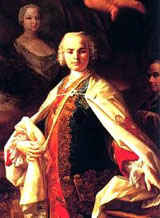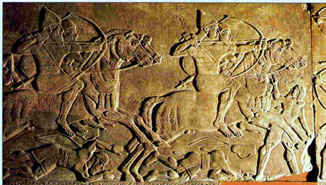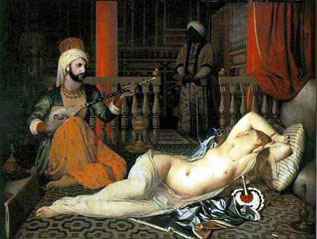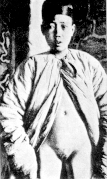|
Eunuchs A eunuch is a castrated human male—that is, a man who has had his testicles removed. The term eunuch can also refer to a man whose penis and testicles have been removed, or even to one who has had only his penis cut off. But while all of these conditions can be referred to as Castration, a man is not a true eunuch as long as his testicles remain intact. As long as the testes function, his body will continue to produce testosterone as well as sperm and he will still (theoretically) be capable of fathering children. In short, a eunuch might be able to get an erection, but he will never be able to reproduce. A eunuch is a castrated human male—that is, a man who has had his testicles removed. The term eunuch can also refer to a man whose penis and testicles have been removed, or even to one who has had only his penis cut off. But while all of these conditions can be referred to as Castration, a man is not a true eunuch as long as his testicles remain intact. As long as the testes function, his body will continue to produce testosterone as well as sperm and he will still (theoretically) be capable of fathering children. In short, a eunuch might be able to get an erection, but he will never be able to reproduce.
The word eunuch comes from the Greek word "eunouchos" and the Latin word "eunuchus"—both meaning "keeper of the bedchamber". And while the word may have originally referred to a person filling this specific career description, the more relevant concept contained within the word is "one who can be trusted to watch over the inner household". Or more to the point, a male servant who won't let anyone (including himself) knock up your wife and daughter while you're away. The idea of the eunuch effectively guarding the household may seem laughable to some. But although eunuchs have endured more than their fair share of scorn and ridicule over the centuries, many ancient cultures acknowledged that despite their literal "lack of balls", eunuchs were not (necessarily) cowards. In fact, the eunuch could often be relied upon to be fierce and loyal guardian of the master's home and family. Like the masters castrated ox, a castrated man could also be strong and well-muscled—and just as steadfast in the face of danger or adversity. And while a lessening testosterone (through loss of testicles) did not significantly lessen the eunuch's courage or his strength, it did however tend to make him calmer and more even-tempered. (Again, like the ox.) As a manservant he was therefore less prone to outbursts of irritability and rage. But while some castrated men were muscular warriors, the once common stereotype of a eunuch—the she-male with soft features, a limp dick, a soft body, and a high falsetto voice—does have some validity. That is, if a male is castrated before puberty, usually before age 10, his body will never experience the normal changes ushered in by the pubescent rush of testosterone. As a result, the castrated boy will retain many of his childlike qualities into adulthood including the inability to get a full erection, and a lack of body and facial hair. He will also have trouble putting on muscle mass. Additionally, pre-puberty castration can cause a condition called macroskelia—meaning very long arms, legs, increased height, and tendency to obesity. A person castrated in infancy may have arms that reach to his knees. When riding horseback, the individuals feet may stretch almost to the ground. On the plus side however, the individual will never experience male pattern baldness—even if his genes call for it. Interestingly enough, the Carrib Indians (for whom the Caribbean Islands are named) were well aware of the effects of early castration and took unique advantage it. That is, because early castration kept the flesh fattier and prevented the muscles from becoming tough and wiry, the Carribs made the habit of castrating their young male captives. They then fed them amply until such time as they were deemed ready to be eaten. (An ugly embellishment on the Hansel & Gretel story.) Not surprisingly, the word "cannibal" is said to derive from the tribe's name.
Although the musical ability of eunuchs had long been recognized in other cultures, and had no doubt been part of the Catholic music scene itself for quite some time, the Catholic Church did not officially acknowledge these boy castrati until 1599 when Pope Clement VIII became smitten with the sweetness and flexibility of their voices. Women were banned from singing in the Church, therefore it was the high vocal range of the castrati that gave devotional music its appealing angelic quality. While some Church officials suggested it would be preferable to lift the ban on women singers than to continue endorsing the castration of little boys, the Pope disagreed, quoting Saint Paul, "Let women be silent in the assemblies, for it is not permitted to them to speak." Of course since it was illegal to perform castrations (transgressors could be excommunicated), all castrati presenting themselves for the choir claimed to have lost their genitals through tragic accident.
Meanwhile, although castration achieved some measure of glamour in the persons of the castrati, most eunuchs were seen as an abomination to the man on the street—for it was taking a man (made in the image of God the Father) and turning him into something else, something strange and exotic. Something tainted with female qualities. Little wonder that fully endowed men saw the castrated as some kind of third gender, and perhaps even as a frightening reminder that there but for the grace of God go I. For against his own will, here was a man made to look and act unmanly.
This intense repellance makes it all the more bizarre that eunuchs have such a long history within the human race. Just how long is hard to say. But while human beings may have been mutilating each others genitals since time immemorial, most historians believe that organized castration probably began some time after the domestication of animals (which occurred roughly 10,000 years ago.) The theory here is that once human beings had explored the possibilities of cutting genital parts off their animal friends, they were eager to explore the practice with their neighbors. Whether this theory is true or not, we do know that 6,500 years ago human beings were castrating cattle in Eastern Europe, and 6,450 years ago (i.e. 50 years later), images were inscribed on the walls of an Egyptian tomb that displayed dancing women guarded by eunuchs. Oddly enough (or maybe not) the same parts of the world that first developed civilization—writing, agriculture, organized government, armies, taxes— also developed organized castration. Namely, Egypt, the Middle East, the Mediterranean, and China. Although there is considerable variation from culture to culture as to how and why castration was practiced, all seemed to share its use as a punishment for adultery, rape, and homosexuality.
Certainly a sadistic need to demoralize the vanquished was motive enough for these proceedings. But there were other reasons for creating these young eunuchs—as slaves they were not only more even tempered but also exotic and sexually sterile. And because they could not reproduce, eunuchs made not only ideal guardians of the harem, but also excellent bureaucrats and priests. That is, unable to fulfill the normal dream of siring a family and becoming a great patriarch (surrounded by children, wives, and flocks) the eunuch was thought to devote himself entirely to the service of the master whether king, nobleman, merchant, or temple priest.
Certainly loyalty and sterility were the eunuch's ticket into the harem. However, their lack of conventional sexual equipment did not always ban exclude them from sexual activity. In fact, some eunuchs had an expressly sexual relationship with their masters. Homosexual slave owners, or especially those with pedophilic leanings, expressly enjoyed the effeminate or eternal boy look of slaves castrated before puberty. In fact, sometimes the manner of castration left the testicles crushed but not removed, precisely because it was hoped that the boy would retain erotic sensation (while losing his reproductive ability). But dirty old men were not alone in their appetites for eunuchs. Many rich women preferred the hard shafts of those ox-like men castrated after puberty. If still able to achieve an erection, such a eunuch could pleasure the mistress without impregnating her. And being the slave, it was his job to satisfy her (while in the marriage bed it was the woman who was the utility). Such goings on were typically very secretive, not because of modesty, but because they were often punishable by death. By contrast however, certain religious orders (such as the cult of Cybele) had eunuch servants who participated openly in naughty revelries dedicated to their deity.
Cultures also varied as to how harsh or gentle the emasculation process was. Among the Ancient Egyptians for example, the boy was strapped to a table, his genitals were bound with yarn, and his penis and testicles were cleanly sliced off total, radical castration. The wound was then cauterized in one of various messy ways (including burning with hot tar), and then a metal rod was inserted into his urethra to keep it from sealing shut. Next the young eunuch was buried up to his navel in hot sand or mud and left for five or six days with no food or drink allowed. Not surprisingly only 20 to 40% of the boys survived. By contrast one of the gentler methods was practiced in Southern India where the boy or man was given opium. Then while seated, his organs were clamped in bamboo and removed with a razor. The wound was washed and sterilized in hot seed oil and covered with an oil-soaked cloth. The eunuch was fed milk and allowed to rest until healed. The survival rate was exceedingly high. Kindest of all was an approach recorded in Catholic Italy in which the boy was drugged (often with opium), and then placed to soak in a tub of very hot water until he was nearly unconscious. The surgeon then merely cut the ducts that lead to the testicles, which later shriveled up. Given the pain, interruption of sexual and reproductive function, and the overall repellence of the balled to becoming the de-balled, it is easy to understand how castration was at times reasoned to be an effective punishment for adultery, rape, or homosexuality. In addition, all through the Middle Ages and on into the Reformation, it was popular to have ones enemies falsely accused of such crimes, and thereby castrated, for in this way you could kill them and still have them live to see you gloat. But by the 19th Century it appeared that organized castration was on its way out. In 1857 the slave trade was banned in the Ottoman Empire. And in Egypt, shortly thereafter, both slavery and castration were outlawed. In 1902 the Vatican had banned the use of castrati in all church music. And in 1924 the palace eunuch system was ended in China. Finally, in 1955, eunuchs (and harems) were outlawed in India. And although castrating criminals and undesirables had a brief comeback among the Nazis (not to mention the Klu Klux Klan), this practice too has been abandoned. One might expect then that (accidents with farm equipment and grenade shrapnel aside) the eunuch is nothing but a cultural anachronism, a way of life that will soon be no more. But of course no practice, no belief, exists for six thousand years unless it is deeply rooted in the human psyche. The tendency to demand eye for an eye style justice is experiencing resurgence as various groups, in countries scattered all over the globe, clamor for a harsher deterrent to crimes of rape and child molestation. Certain states within the U.S. have actually successfully instituted new laws demanding or offering chemical or surgical castration to criminals convicted of rape or child molestation. While there are certainly many fans of this development, it would be a mistake to assume that either method of castration effectively removes the sadistic fantasies and tendencies that actually lead someone to commit rape. Like courage, sadism exists in the mind and the character not in the testicles. And as a thorough reading of any sadists biography will inform one, it doesnt require a sperm-squirting penis to violate another persons sexual parts. Meanwhile whether or not the U.S. actually gets around to castrating criminals, Americans are already witnessing the creation of 21st century eunuchs in the persons of Male-to-Female transsexuals. In this new twist on an old theme, the men bidding good riddance to their balls are not seeking (necessarily) operatic musical careers or even a cushy job in a harem, but a chance to express who they feel they really are inside female. Now, thanks to hormone treatments and further advancements in modern surgery, every guy whod rather be a gal can have his weenie whacked off and delicately transformed into a tunnel of love complete with pulsating orgasmic potential. Recent medical advances are also coming to the aid of another type of modern eunuch those who have lost their balls to cancer (and other mishaps and diseases). Now those longing to restore virility to their testicle-free lifestyle can find help through testosterone implants, chemical and mechanical erection enhancers, and even implanted testicle prosthetics. Thats right, now women and men can have a pair of silicone falsies to jiggle around. Finally, this being the Rotten Library, we simply cant conclude a discussion of eunuchs without mentioning the most bizarre 21st Century eunuch of them all, the self-un-made man. In a era of expanding tolerance and education, where political correctness often stays the hand of angry Klan members, Hell's Angels, and assorted other bigots, certain unusual individuals (who surely would have been targeted in an earlier era) have taken it upon themselves to maim and mutilate their own bodies. With kitchen knife or Cuisinart in hand, they liberate themselves of toes, fingers, and yes even cocks and testicles effectively removing themselves from further contribution to the gene pool. Unlike self-un-made men of earlier centuries, they do not seek chaste lives in the clergy. Instead, mutilation is their art form. Their body is the canvas. And the gallery is your own computer, surfing the web. Make of it what you will. One cannot help but wonder: is such behavior an example of stifled human creativity seeking negative outlet in order to thwart the uniformity of modern life and conditioned expectation, or is it simply Darwinism in action? One thing is certain, the persistence of the eunuch (as a social role) over countless millennia of human existence suggests to us that the human psyche longs to express itself in forms more complicated than the simple dualism of male and female.
Related Trivia
|
 Dining peculiarities aside, most boys ushered into eunuchhood were made thus in order to become members of an exotic "third sex". In Italy the practice reached its pinnacle in the form of the "castrati", the young she-males who lent their angelic voices to the choirs and operas of the Catholic Church. Dolled up in their foppish clothes, with their rounded faces, and pale complexions, they were said to exude a profound sense of "otherness"—to the delight of some and the horror of others. Their voices, raised in song, were unlike any other human voice. They sounded neither male nor female nor even like that of a child. They were unique. They werecastrati.
Dining peculiarities aside, most boys ushered into eunuchhood were made thus in order to become members of an exotic "third sex". In Italy the practice reached its pinnacle in the form of the "castrati", the young she-males who lent their angelic voices to the choirs and operas of the Catholic Church. Dolled up in their foppish clothes, with their rounded faces, and pale complexions, they were said to exude a profound sense of "otherness"—to the delight of some and the horror of others. Their voices, raised in song, were unlike any other human voice. They sounded neither male nor female nor even like that of a child. They were unique. They werecastrati.
 After the Popes official acknowledgement and acceptance of castrati, the number of these "accidents" increased dramatically. Parents seeking upward mobility towed their little lads down to a barber or butcher who separated them from their testicles for a fee. However, mere ball lopping did not a singer make. One still had to have a remarkable voice to qualify for the choir (and later, the operas). As a result, many boys found themselves needlessly lightened of their rightful loads. Still, few were left completely out in the cold. Since celibacy and pre-pubescent castration went hand in hand, many of these lads eventually found other places within the Church. As a result, all the churches in Italy soon had castrati staff.
After the Popes official acknowledgement and acceptance of castrati, the number of these "accidents" increased dramatically. Parents seeking upward mobility towed their little lads down to a barber or butcher who separated them from their testicles for a fee. However, mere ball lopping did not a singer make. One still had to have a remarkable voice to qualify for the choir (and later, the operas). As a result, many boys found themselves needlessly lightened of their rightful loads. Still, few were left completely out in the cold. Since celibacy and pre-pubescent castration went hand in hand, many of these lads eventually found other places within the Church. As a result, all the churches in Italy soon had castrati staff.
 Additionally, the Persians, the Assyrians, the Medes, the Hebrews, the Egyptians, and the Ethiopians all castrated their vanquished enemies unmanning them in order to demoralize and further subdue them. Baskets of severed penises became war trophies. In 1300 B.C.E., the Egyptian King Meneptah allegedly took 13,230 penises from an invading Libyan army (with six of those belonging to generals). And when it was the invaders themselves who were victorious, such grisly trophies were augmented by the capture of and castration of children. Specifically, the invaders would select the most attractive young boys to be made into eunuchs. (Girl children were also taken away to serve the king).
Additionally, the Persians, the Assyrians, the Medes, the Hebrews, the Egyptians, and the Ethiopians all castrated their vanquished enemies unmanning them in order to demoralize and further subdue them. Baskets of severed penises became war trophies. In 1300 B.C.E., the Egyptian King Meneptah allegedly took 13,230 penises from an invading Libyan army (with six of those belonging to generals). And when it was the invaders themselves who were victorious, such grisly trophies were augmented by the capture of and castration of children. Specifically, the invaders would select the most attractive young boys to be made into eunuchs. (Girl children were also taken away to serve the king).
 While being wrenched from home and family and physically brutalized, these child eunuchs did receive some benefits that other children did not. They often became playmates of royal children (who lived in the harem), forming tight bonds that led to their being appointed to jobs of great prestige and responsibility. In fact, the mere presence of the eunuch in the harem gave him opportunities to form bonds with the royal family that outsiders bitterly envied.
While being wrenched from home and family and physically brutalized, these child eunuchs did receive some benefits that other children did not. They often became playmates of royal children (who lived in the harem), forming tight bonds that led to their being appointed to jobs of great prestige and responsibility. In fact, the mere presence of the eunuch in the harem gave him opportunities to form bonds with the royal family that outsiders bitterly envied.
 Just as behavior toward eunuchs varied from one culture and era to the next, so too did the manner of creating a eunuch. In certain cultures, as in China and Egypt, it was preferred to so radically emasculate the boy that he had nothing left but a hole to squat and pee through, a hole which was not always easy to maintain control of leading to the need to carry some form of plug, to prevent wetting accidents.
Just as behavior toward eunuchs varied from one culture and era to the next, so too did the manner of creating a eunuch. In certain cultures, as in China and Egypt, it was preferred to so radically emasculate the boy that he had nothing left but a hole to squat and pee through, a hole which was not always easy to maintain control of leading to the need to carry some form of plug, to prevent wetting accidents.